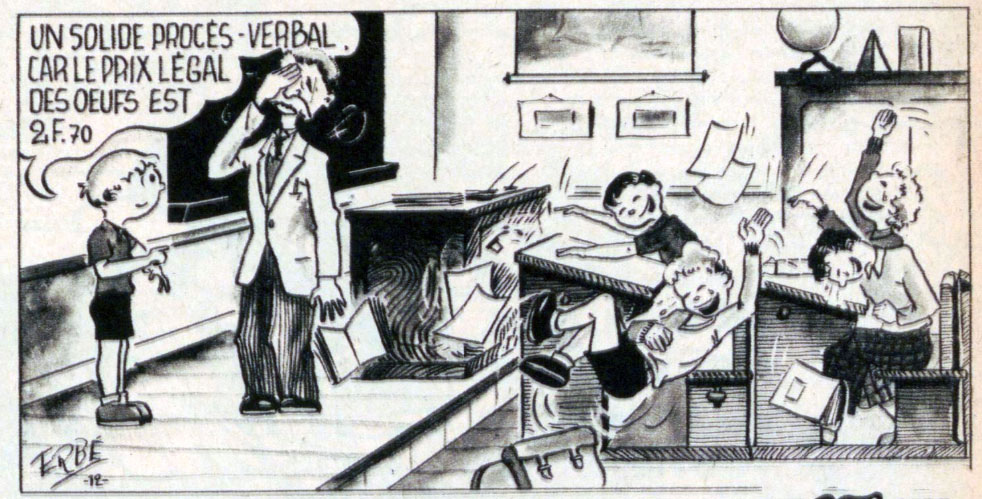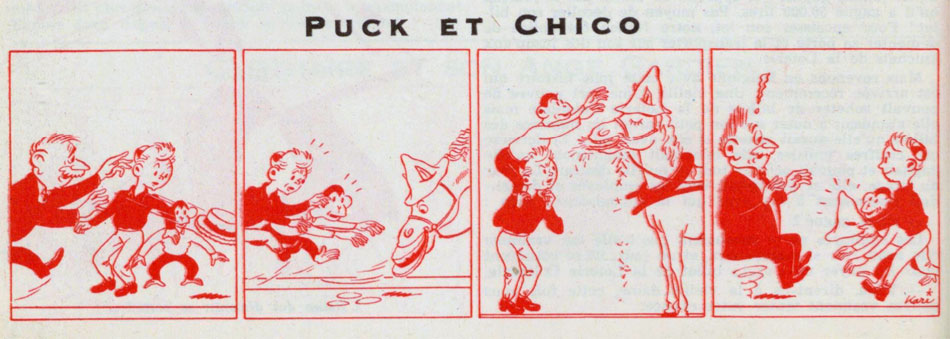'Monsieur VéWé à San Cylindro' (Line issue #104, 8 March 1957).
The signature of Kari appeared on several classic 1950s advertising strips, printed in Belgian comics weeklies like Tintin, Line and Spirou. The artist was also an illustrator for newspapers, magazines and Scouts calendars. Throughout the years, the true identity of Kari remained a mystery to comic historians and researchers. Later it was revealed that Kari was the pen name of Kaja Kengen, a German refugee who came to Brussels during the war. But the true story is more complicated than that, as Kari was in fact a front for Kaja's husband, Dutch-born Anselmus Kengen... the actual cartoonist!
Background
Anselmus-Henricus Kengen was born on 3 November 1916 in Eijsden, near Maastricht in the Netherlands. He studied journalism and can be described as a convinced Francophile. He kept his Dutch nationality until his death. His wife Kaja Grünwald was born on 14 February 1925 into a German Jewish family in Iéna. Before the war, her father Richard sent her to Belgium, along with her sister and mother, pregnant with a son, to escape the pogroms. Following their meeting, Anselmus helped Kaja and her family, hiding them and feeding them in a Brussels attic where the family lived. Kaja's sister died of severe leukemia there. Anselmus and Kaja married in 1947. To provide for his wife and her family, Anselmus had to do some small trafficking on the black market. As a result, the post-war justice system, sometimes expeditious, forbade him to continue his work as a journalist.
'Aristide Duracuir' in Grand Coeur #54 (26 December 1946) by Erbé. Is this also Kari?
Cartoonist
To earn a living, Anselmus exploited his gift for drawing, but it was Kaja who had to present herself as the cartoonist to the newspapers and press agencies. Quickly, Kari's art appeared in several Belgian newspapers and magazines, and later also on Belgian television. Kari was a member of La Mine Souriante, a Belgian association of humorous cartoonists, founded in 1930 by Marcel Antoine and later chaired by Horn. In the book 'Dictionnaire Illustré de la Bande Dessinée Belge de la Libération aux Fifties (1945-1950)' by Frans Lambeau, Kari's name is connected to several comic strips that were signed with other names, opening the possibility that he/she used different pseudonyms before settling on Kari. Several of these early features were humorous comic strips or gag pages with a variety of funny/unlucky characters. Possible Kari creations were 'Floris Pipeau' (1946, later 'Félix Pipeau') and 'Rob, Line et Annibal' in Bravo!, which were signed with "Kyra", as well as 'Polo' in Wrill, which was signed with "Frick". Between 10 October 1946 and 27 February 1947, Charles Gilbert's Grand Coeur ran a comic strip called 'Aristide Duracuir', signed by "Erbé", also possibly a pen name for Kari.
'Puck et Chico' (L'Aiglon #8, 1 August 1949).
Between 1946 and 1949, Kari's cartoons appeared in the daily La Nation Belge. In 1949, the signature of Kari also appeared in L'Aiglon, the children's monthly of the Aiglon chocolate factory, which ran the cartoonist's pantomime comic strip 'Puck et Chico', about a boy and his pet monkey. After that, Kari made illustrations and sports-related gags for Spirou (1951), and illustrations for calendars of the Belgian Federation of Catholic Scouts (1959). The couple also compiled a cartoon collection about the lives and customs of the people of Brussels, called 'Bruxelles ô gai' (Editions de l'Imprimerie Nouvelle, 1954). During the 1960s, Kari had a long spell as a cartoonist for the socialist weekly Germinal.
Illustration for Spirou/Robbedoes in 1951.
Advertising comics
During the 1950s and 1960s, Kari was the artist of several advertising comic strips, which appeared in Belgian comic magazines. Their ad strip for Frisko chocolate, 'Les Exploits de Friskotin et Friskinette', was published in Tintin in 1950. The advertising serial 'Monsieur Véwé à San Cylindro' for Volkswagen ran both in Tintin and its counterpart for girls, Line, in 1957. In 1956, Kari was the illustrator for the first issue of Revue du Club Pierrot/Tijdschrift van Pietje's Club, the magazine of the youth club of the Spa Monobole mineral water brand. The subsequent issues had artwork by Jean Graton and then Tenas.
An extensive campaign with art by Kari for Sheaffer's pens, starring the character 'Zippy', was published in Spirou and Tintin during the first half of the 1960s. One booklet collection called 'Sheaffer's Présente Zippy, Roi du Far-West' also ran in both the French and Dutch language. Their advertising strips for Fiat appeared in newspapers like Le Soir in 1960. Another advertising strip by Kari was 'Les Aventures de Tata Bata, Vendeur d’Élite', published in a landscape format-shaped booklet for Bata shoes in Belgian Congo.
Final years and death
By the 1980s, the Kengen family lived in Uccle, and made illustrations for the publications of Touring-Secours. Both Kaja and Anselmus have also worked as translators. Anselmus Kengen died in Brussels in 2001, Kaja continued to live there until her own death in 2021. On 29 April 2015, she brought her life story onstage in the Brussels Académie d'Auderghem.
'Zippy, Roi du Far West' (Dutch-language edition from Robbedoes #1264, 5 July 1962).








